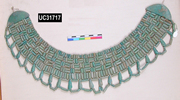
Natural properties of linen
Untreated flax or linen fibres are usually pale golden brown or 'écru'. They become whiter as a result of washing and particularly by exposure to the sun when wet. It appears that, in ancient Egypt, fine linen clothing could be made of flax that had been harvested when still green, and, because of the method of processing used then, this green colour could be maintained throughout spinning and weaving. At different periods light brown, very white, and pale green clothing carried implications for status, as they indicated that the garments were new. Fresh garments would also have been stiffer, effectively starched, because the natural pectin in the fibre had not yet been washed out. This stiffness, together with the volume of woven fabric involved, probably accounts for the sharply defined triangular fronts in depictions of elite men wearing garments - as on the late Middle Kingdom stela UC 14417 (see the image below).
This natural starch also enabled the woven linen to be pleated; there are examples of pleating in surviving garments of the Old Kingdom (2686-2181 BC), and in depictions of various periods.
 |
Example of pleating: the upper part of a sleeved dress from Tarkhan UC 28614Ai |
Adding colour: pigments and dyes
Flax/linen is a form of cellulose, and is particularly difficult to dye. This is in contrast to protein fibres deriving from animals, most importantly wool. The great majority of linen was therefore left without additional colour. One method was to apply pigment, effectively coating the fibres. Both yellow and red ochre (iron-rich earths naturally occurring in Egypt) had been used to colour some textiles found in Old Kingdom burials.
The Egyptian language includes a special word for red cloth - insy. This was among the cloths offered in the daily offering ritual before sacred images.
An early true dye, which is effective on linen, is a combination of tannin from plants and reduced iron contained in certain muds (these must be wet, and are to be distinguished from the dry ochres mentioned above). This could be used to colour whole cloths various shades of brown, but in fact most often occurs as a writing ink for marking linen. Surviving examples date to the Middle Kingdom (2025-1700 BC) and later; examples in the Petrie Museum are from the late Third Intermediate Period or Late Period (about 700 BC). Note the corrosion caused by the iron eating into the linen.
Other true dyes include blue from woad, generally employed for stripes at the side of tunics in the New Kingdom and later. Madder, a red dye, was used similarly, but without a mordant until the first millennium BC, and therefore early examples have faded to a soft pink. A non-fast red dye important in the first millennium BC was safflower. Safflower combined with a weak iron tannin mixture was used to colour whole textiles red-brown. These occur as shrouds stretched over wrapped mummies, and the colour can be compared to the red ochre known from the Old Kingdom.
Adding colour: beads and jewellery
Colour could be added by other items worn over the plain linen garment. Most often this would be jewellery such as necklaces and collars, worn by both men and women.
 |
Collar of blue faience beads from Sedment, First Intermediate Period, UC 31717 |
Occasionally more dramatic examples survive, such as the bead-net dresses of Old Kingdom dancing-girls
In addition, figural motifs could be composed in multicoloured beadwork: most surviving examples are from first millennium BC burials, though there are also fine examples from the tomb of Tutankhamun (1333-1323 BC).
Copyright © 2003 University College London. All rights reserved.